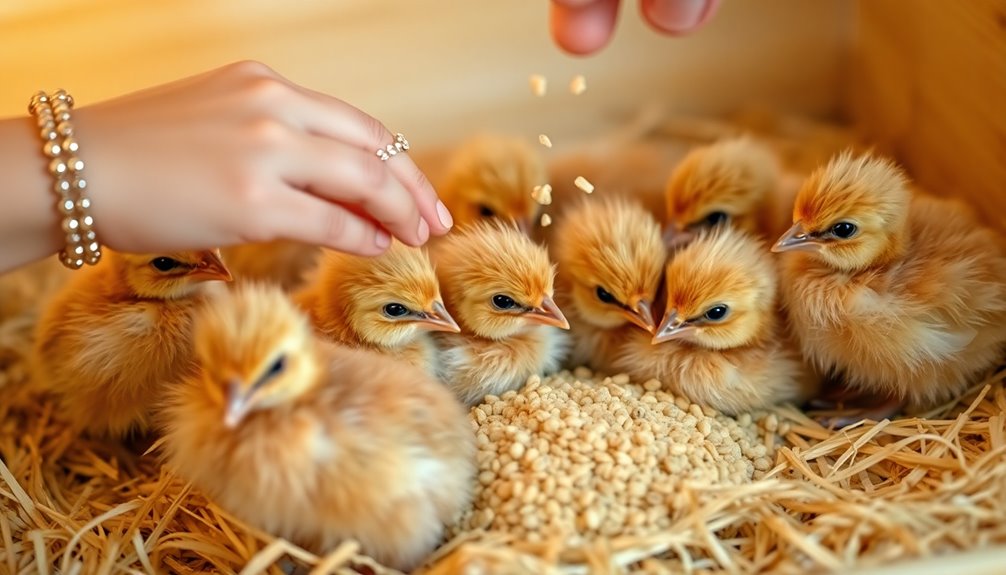In wet autumn conditions, you should watch for hoof rot signs like swelling, foul odor, pus, and lameness. Regularly inspect your horse’s hooves for cracks, excess moisture, or debris trapped inside. To treat, clean and dry the hooves first, then apply an antimicrobial solution and cover with a dressing. If symptoms worsen or persist, seek professional veterinary care promptly. Staying aware now can help protect your horse’s hoof health long-term.
Key Takeaways
- Regularly inspect hooves for swelling, foul odors, cracks, or abnormal wear, especially in wet, muddy autumn conditions.
- Use antimicrobial hoof treatments like iodine or copper sulfate to disinfect affected areas thoroughly.
- Keep hooves dry and clean by picking out debris daily and applying protective dressings or boots.
- Seek prompt veterinary care if signs of severe infection, such as pus, deep tissue damage, or persistent lameness, appear.
- Maintain good hoof hygiene, proper trimming, and a balanced diet to prevent recurrence and promote healing.
Understanding Hoof Rot and Its Causes

Hoof rot, also known as interdigital dermatitis, is an infection that occurs when bacteria or fungi invade the sensitive tissue between your horse’s hooves. It thrives in wet, muddy conditions, especially during autumn when moisture lingers around the hooves. Poor hygiene, such as standing in muddy paddocks or not cleaning your horse’s hooves regularly, increases the risk. Overgrown or cracked hooves provide entry points for pathogens, making infection more likely. The moisture softens the tissue, creating an ideal environment for bacteria and fungi to proliferate. If your horse’s environment stays damp and dirty, it’s easier for hoof rot to develop. Recognizing these causes helps you take preventative steps, like cleaning and drying the hooves thoroughly after turnout. Additionally, using vertical storage solutions can help organize your horse care supplies, ensuring products like disinfectants and hoof tools are readily accessible for regular maintenance.
Common Signs and Symptoms of Hoof Rot

If your horse has hoof rot, you’ll notice certain signs that indicate infection. The affected hoof may appear swollen, with heat radiating from the area. You might see a foul odor coming from the hoof, often accompanied by a yellowish or greenish discharge. The hoof wall can become soft, cracked, or separated, revealing underlying tissue. You may also observe lameness or reluctance to bear weight on the affected leg. Sometimes, the digital pulse in the pastern area becomes more pronounced. In early stages, the damage might be subtle, but as it progresses, these symptoms become more obvious. Recognizing these signs early helps you seek prompt treatment, preventing further damage and ensuring your horse’s comfort and health. Early detection is crucial in minimizing the severity of hoof rot and promoting quicker recovery.
The Impact of Wet Conditions on Hoof Health

Wet conditions considerably increase the risk of hoof problems like hoof rot by creating an ideal environment for bacterial growth. When your land stays muddy and damp, bacteria thrive, attacking the hoof tissue and causing infections. To understand this impact better, consider these points:
Wet, muddy conditions promote bacterial growth, increasing hoof rot risk and delaying healing.
- Increased moisture softens hooves, making them more vulnerable to injury.
- Standing water exposes hooves to prolonged wetness, promoting bacterial and fungal growth.
- Muddy, wet environments trap dirt and debris, which can introduce pathogens into minor cracks.
- Constant dampness hampers the hoof’s natural ability to dry and heal, prolonging infections.
- Using portable hoof cleaning tools can help remove mud and debris, reducing the risk of infection.
Staying aware of these factors helps you recognize the risks and take timely action to protect your horse’s hoof health during wet autumn conditions.
Preventative Measures During Autumn
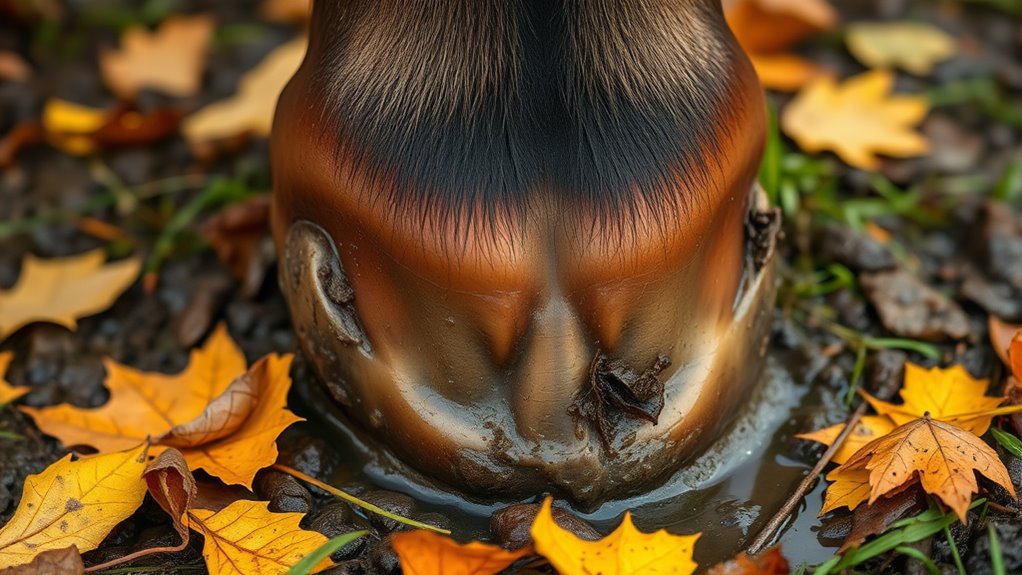
Autumn brings cooler, wetter weather that increases the risk of hoof problems, but you can take proactive steps to protect your horse. First, confirm your horse’s feet are clean and dry before turnout or riding. Regularly pick out their hooves to remove mud, manure, and debris, which can trap moisture and promote infections. Consider using dry, well-ventilated bedding in stalls and avoid overly muddy or wet turnout areas. Applying hoof dressings or protective boots can also help shield hooves from excess moisture. Keep your horse’s diet balanced to support hoof health, including adequate biotin and zinc. Finally, monitor weather forecasts and avoid prolonged exposure to wet conditions. These measures help minimize the risk of hoof rot and keep your horse healthier through autumn’s damp months. Additionally, consulting with a veterinary professional can provide personalized advice on maintaining optimal hoof health during this season.
How to Inspect Your Horse’s Feet Effectively
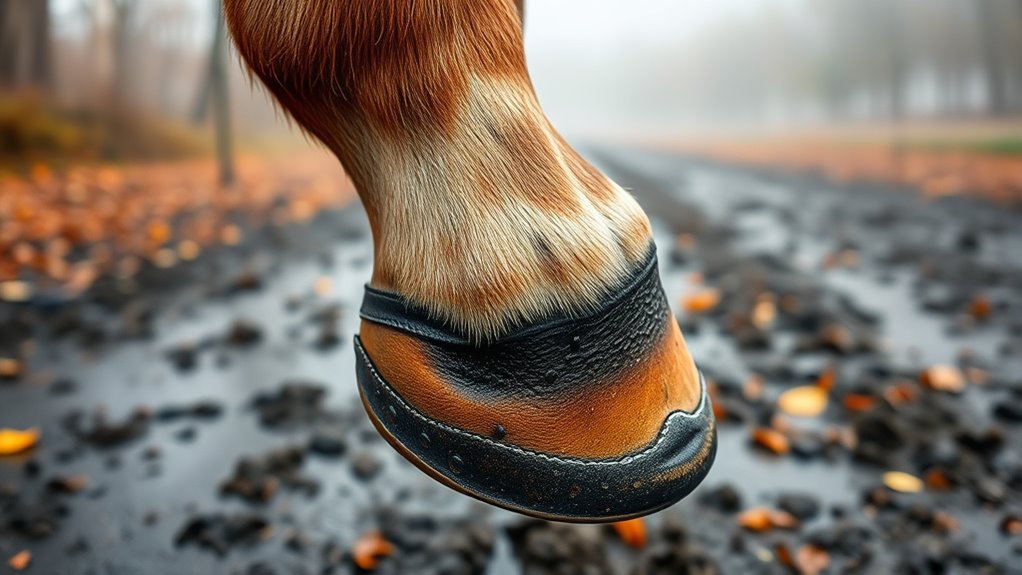
Regularly inspecting your horse’s feet is a vital part of maintaining hoof health, especially during seasons when moisture increases the risk of infections like hoof rot. To do this effectively:
- Check for any cracks, chips, or unusual wear that may trap dirt or moisture.
- Examine the hoof wall and sole for swelling, discoloration, or foul odors indicating infection.
- Look between the hoof and the frog for excess moisture, debris, or signs of inflammation.
- Gently lift each hoof, supporting the limb, and feel for heat or tenderness, which could signal an issue.
- Monitoring digital health can help identify early signs of hoof problems and prevent more serious issues from developing.
Performing these checks daily helps catch problems early, allowing you to respond quickly and keep your horse’s hooves healthy and strong.
Cleaning and Maintaining Hooves to Prevent Infection

To prevent hoof infections like hoof rot, it’s essential to clean and maintain your horse’s hooves consistently. Regularly pick out dirt, mud, and manure to reduce the moisture that fosters bacterial growth. Use a stiff-bristled brush to remove debris from the sole, frogs, and heel areas. After cleaning, inspect hooves carefully for cracks, punctures, or signs of infection. Applying hoof oil or conditioner can help keep hooves healthy and resilient, especially during wet autumn conditions. Keep the hoof wall trimmed and balanced to prevent trapping moisture and debris. Proper hoof care is crucial for maintaining overall hoof health and preventing issues like hoof rot. If you notice any signs of infection or damage, address them promptly. Consistent hoof maintenance not only prevents hoof rot but also promotes overall hoof health, ensuring your horse stays comfortable and sound.
Choosing the Right Treatment Options
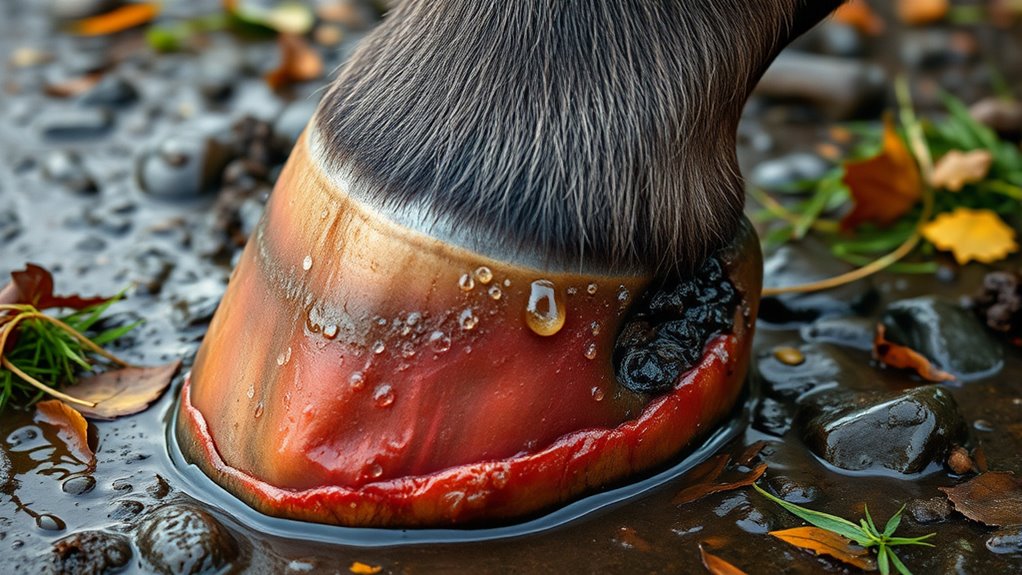
When you notice signs of hoof rot, selecting the right treatment options becomes vital to stop the infection and promote healing. First, determine the severity; mild cases may only need topical treatments, while advanced cases might require systemic antibiotics. Second, consider environmental factors—keep the horse in dry, clean areas to prevent further spread. Third, consult a veterinarian for proper diagnosis and tailored treatment plans. Fourth, prioritize treatments that remove decayed tissue and reduce bacterial load. Options include antiseptic dips, prescribed antibiotics, and hoof trimming to remove affected tissue. Additionally, understanding how tuning options can enhance performance and recovery is beneficial for overall hoof health. Avoid using harsh chemicals or unapproved remedies, and always follow veterinary guidance. Choosing the correct treatment saves time, prevents complications, and encourages faster recovery.
Applying Topical Medications and Dressings
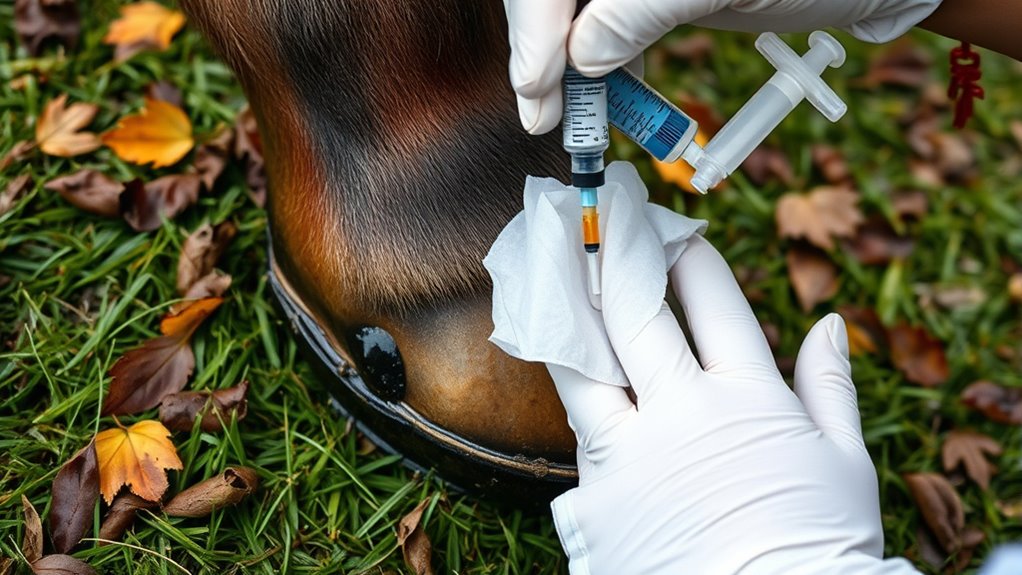
When applying topical medications and dressings, you need to select the most effective treatments for the infection. Proper dressing techniques guarantee the medication stays in place and promotes healing. Paying attention to these details helps you give your horse the best chance to recover quickly. Additionally, ensuring the dressings are clean and dry prevents further contamination and supports the healing process.
Choosing Effective Medications
How do you guarantee that topical medications effectively treat hoof rot? First, choose medications with proven antimicrobial properties, such as iodine-based solutions or copper sulfate. Second, ensure the product is specifically formulated for hoof infections, not just general antiseptics. Third, follow the manufacturer’s instructions regarding application frequency and amount; over- or under-application reduces effectiveness. Fourth, regularly inspect the hoof to confirm the medication reaches affected areas and stays in place. Using the right medication consistently helps eliminate bacteria and prevent recurrence. Remember, selecting a product tailored for hoof rot maximizes healing potential, so always read labels carefully and consult your veterinarian if unsure. Proper medication choice is essential for rapid recovery and long-term hoof health. Additionally, product safety should be considered to prevent any adverse reactions or damage to healthy tissue.
Proper Dressing Techniques
Are you applying topical medications and dressings correctly to guarantee effective hoof rot treatment? Proper technique guarantees the medication stays in place and works effectively. First, clean the hoof thoroughly to remove debris and dead tissue. Dry the area completely before applying the medication. Use a brush or spatula to spread the medication evenly over the affected area. Cover with a suitable dressing, securing it firmly but comfortably. To help you remember, here’s a quick guide:
| Step | Key Point |
|---|---|
| Clean the hoof | Remove debris and dead tissue |
| Apply medication | Spread evenly over the affected area |
| Secure the dressing | Ensure it stays in place without tightness |
Consistent, correct dressing techniques promote faster healing and prevent reinfection. Incorporating evidence-based practices can further improve treatment outcomes.
When to Seek Professional Veterinary Care

If you notice signs like increased swelling, foul odor, or your horse’s lameness worsening, it’s time to see a vet. Prompt professional care is essential when symptoms seem severe or don’t improve quickly. Recognizing these warning signs helps prevent the condition from worsening and guarantees your horse gets the right treatment.
Signs of Urgent Need
When you notice signs of severe discomfort or worsening symptoms in your horse’s hoof, it’s essential to seek professional veterinary care immediately. Ignoring these signs can lead to serious complications. Here are four urgent indicators:
- Extreme lameness or inability to walk
- Significant swelling or heat in the hoof or leg
- Foul odor or pus draining from the hoof
- Visible tissue damage or open wounds
If you observe any of these, don’t delay—call your vet promptly. Quick action can prevent the infection from spreading and save your horse from long-term damage. Trust your veterinarian’s expertise to provide effective treatment and relief. Early intervention is indispensable to restore your horse’s hoof health and comfort.
Timing for Vet Visits
Timely veterinary visits are crucial at the first signs of hoof rot to prevent the infection from worsening. If you notice persistent lameness, foul odor, or visible swelling and decay, don’t delay. Early intervention is key to stopping the spread and minimizing damage. Schedule a vet appointment promptly when symptoms first appear, rather than waiting for the condition to worsen. A veterinarian can properly diagnose the extent of the infection and recommend effective treatment. Waiting too long risks the hoof deterioration becoming more severe, leading to longer recovery times and higher costs. Trust your instincts; if you’re unsure or symptoms persist beyond initial treatment, seek professional care immediately. Acting quickly can save your horse from unnecessary pain and more complicated issues down the line.
Recognizing Severe Cases
Severe cases of hoof rot require immediate professional attention to prevent irreversible damage. If you notice any of these signs, don’t delay in calling your vet:
- Excessive swelling or pus around the hoof or fetlock
- Foul odor that intensifies over time
- Lameness that worsens or persists beyond a day
- Cracked or broken hoof wall with deep tissue involvement
These symptoms indicate the infection has advanced and needs specialized treatment. Ignoring them can lead to permanent hoof damage, lameness, or even the need for amputation in extreme cases. Prompt veterinary care ensures proper cleaning, medication, and possibly drainage, helping your horse recover faster and avoiding long-term issues. Always prioritize professional advice when symptoms escalate.
Long-Term Strategies for Hoof Health Management

Maintaining hoof health over the long term requires consistent management practices that prevent recurrence and promote healing. Regularly inspect your horse’s hooves for early signs of problems and keep them clean and dry, especially during wet autumn months. Implement a routine trimming schedule with a qualified farrier to maintain proper hoof shape and balance, reducing stress on sensitive areas. Use appropriate hoof dressings or topical treatments recommended by your veterinarian to support healing. Ensure your horse’s living environment is well-drained and free of mud, which can harbor bacteria. Incorporate dietary supplements that promote hoof strength, such as biotin. By staying vigilant and proactive, you minimize the chances of hoof rot returning and help your horse maintain healthy, strong hooves year-round.
Frequently Asked Questions
Can Hoof Rot Spread to Other Horses in the Herd?
Yes, hoof rot can spread to other horses in your herd. The bacteria causing hoof rot thrive in wet, muddy environments and can transfer through contact or contaminated surfaces. To prevent spread, isolate affected horses, maintain clean, dry stalls, and regularly disinfect equipment. Prompt treatment of infected hooves is essential. By staying vigilant and practicing good hygiene, you reduce the risk of the infection spreading to your other horses.
Are Certain Breeds More Susceptible to Hoof Rot?
Yes, certain breeds are more susceptible to hoof rot. For example, breeds with thick, dense hooves or those prone to moisture retention, like draft horses or heavier breeds, tend to be at higher risk. You should regularly inspect your horse’s hooves, especially if they belong to a susceptible breed, and keep them dry and clean. Early detection and prompt treatment help prevent the spread and severity of hoof rot.
How Quickly Does Hoof Rot Develop Once Exposed to Wet Conditions?
Hoof rot can develop within a few days to a week after your horse is exposed to wet, muddy conditions. The moisture creates an ideal environment for bacteria to thrive, so if your horse’s hooves stay damp for extended periods, the infection can progress quickly. To prevent this, you should regularly check your horse’s hooves, keep them dry, and apply protective hoof dressings if necessary.
Are There Natural Remedies Effective Against Hoof Rot?
Natural remedies can help combat hoof rot, but they work best when combined with proper hygiene and veterinary care. You might consider soaking the affected hoof in a mixture of Epsom salts and apple cider vinegar, which can reduce infection. Additionally, applying honey or herbal poultices may promote healing. However, don’t rely solely on natural remedies; consult your vet for a thorough treatment plan to guarantee your horse’s recovery.
How Can I Prevent Hoof Rot During Prolonged Rainy Seasons?
To prevent hoof rot during prolonged rainy seasons, keep your horse’s hooves clean and dry. Regularly inspect and pick out mud and manure, and make certain stalls are well-drained. Use hoof boots or waterproof shoes when riding in wet conditions. Apply hoof disinfectants as a preventative measure, and avoid standing in muddy, waterlogged areas. Consistent hoof care and maintaining dry, clean environments are key to preventing hoof rot.
Conclusion
Think of your horse’s hooves as a fortress, guarding its well-being. When wet autumn conditions threaten to weaken those walls with hoof rot, your vigilance and quick action can keep the fortress standing strong. Regular inspections, proper treatment, and preventive care are your weapons against this sneaky enemy. Stay attentive and proactive—because, with the right care, you can shield your horse from harm and keep its hooves healthy and resilient all season long.



